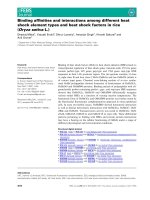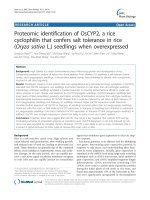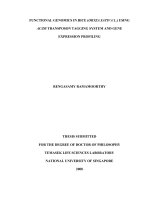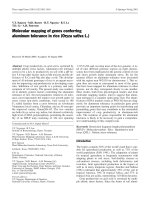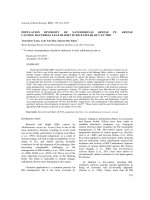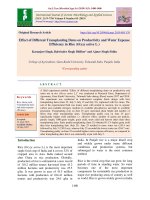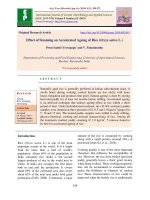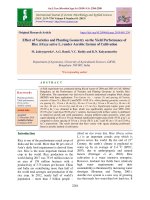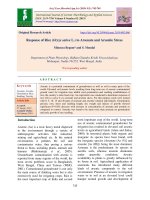Analysis of genetic variability to improve yield and resistance to bacterial leaf blight in rice (Oryza sativa L) germplasm
Bạn đang xem bản rút gọn của tài liệu. Xem và tải ngay bản đầy đủ của tài liệu tại đây (190.15 KB, 7 trang )
Int.J.Curr.Microbiol.App.Sci (2019) 8(4): 52-58
International Journal of Current Microbiology and Applied Sciences
ISSN: 2319-7706 Volume 8 Number 04 (2019)
Journal homepage:
Original Research Article
/>
Analysis of Genetic Variability to Improve Yield and Resistance to Bacterial
Leaf Blight in Rice (Oryza sativa L) Germplasm
Mukul1*, Sandhya2, P.K. Singh3, S.P. Singh3 and Aprajita3
1
Department of Genetics and Plant Breeding, Institute of Agricultural
Sciences, Banaras Hindu University, Varanasi-221005, India
2
Department of GPB, AU, Kota, Rajasthan, India
3
Department of GPB, IAS, BHU, Varanasi, India
*Corresponding author
ABSTRACT
Keywords
Correlation, Genetic
advance, Grain
yield, Heritability,
GCV, PCV
Article Info
Accepted:
04 March 2019
Available Online:
10 April 2019
One hundred indigenous collection of rice germplasm were evaluated for ten quantitative
traits to assess the genetic variability, heritability, associations and estimation of yield
related traits including area under disease progress curve for bacterial leaf blight. was
present for all the traits,. In all germplasm, the analysis of variance revealed a wide range
of variability and significant differences for the characters under study, indicating the
presence of high genetic variability among the genotypes and considerable scope for
selection. The estimates of genotypic coefficient of variance were lower than the
respective phenotypic coefficient of variance, indicating the influence of environmental
factors on the expression of the traits studied. The high heritability was observed for grain
yield per plant, thousand grain weight, total spikelets per panicle, number of effective
tillers per plant, plant height, grain weight per panicle, days to maturity and days to 50 per
cent flowering. The phenotypic correlation coefficients were positive and highly
significant between grain yield per plant with days to 50% flowering, days to maturity,
total spikelets per panicle, grain weight per panicle and thousand grain weight. The
correlation between area under disease progress curve and number of effective tillers per
plant and thousand grain weight was positive.
devastating diseases affecting entire rice
acreage. It causes severe yield losses of up to
80%, depending on the different stage of the
crop, cultivar susceptibility and the
environmental conditions (Srinivasan and
Gnanamanickam, 2005).
Introduction
Rice (Oryza sativa L.) is one of the oldest
domesticated cereal crops which provides
food for more than half of the world’s
population and constitutes a major source of
calories for urban and rural inhabitants
(Khush, 2005). Xanthomonas oryzae pv.
oryzae (Xoo) is the causal organism of
Bacterial leaf blight disease, one of the most
Crop improvement for grain yield has been
achieved in rice through effective use of
germplasm and fixing desirable traits
52
Int.J.Curr.Microbiol.App.Sci (2019) 8(4): 52-58
combinations. However, there are still
possibilities to increase the yield output
through proper breeding technologies along
with molecular studies. Grain yield is a
complex quantitative trait and is the result of
interaction of many variables. The existence
of correlation between traits may be attributed
to the presence of linkage or pleiotropic effect
of genes or physiological and development
relationship or environmental effect or in
combination of all (Oad et al., 2002). The
importance of correlation analysis is
particularly appreciable when highly heritable
characters associated with a complex trait like
yield and particular a disease resistance are
identified, and successfully used as criteria for
effective selection to achieve high yield. To
accumulate yield contributing characters
together with bacterial blight resistance, it is
essential to know the association among
various traits. Therefore, the present
investigation was undertaken to study the
variability, heritability and estimation of
associations for yield related traits in
indigenously collected rice germplasm and
possible breeding strategies to improve yield
with enhanced resistance are discussed.
between plants. The recommended packages
of practices were followed to raise healthy
crops.
The culture of Xanthomonas oryzae pv.
oryzae (strain BX043 wild type) was obtained
from Department of Mycology and Plant
Pathology IAS, BHU and subcultured on
peptone sucrose agar medium and maintained
it at pH 7.2 - 7.4 (Fahy and Persley, 1983) and
pathogenicity test, clipping method was used
to inoculation the rice plants with
Xanthomonas oryzae pv. oryzae. After
inoculation, the plants were observed after
every 24 hrs time intervals to note the
appearance of disease symptoms, and lesion
length were recorded at 8, 16, 24 and 32 days
after inoculation (DAI).
After eliminating the border plants,
observations were recorded on ten randomly
selected plants from rice germplasm including
two checks from each replication on days to
50% flowering (DF), days to maturity (DM),
plant height (PH), panicle length (PL), Grain
weight per panicle (GWP), number of
effective tillers per plant (ET), total number
of spikelet per panicle (TSP), thousand grain
weight (TGW), grain yield per plant (GYP)
and area under disease progress curve
(AUDPC), and mean value were used for
statistical analysis.
Materials and Methods
The hundred rice germplasm including two
checks PB-1and IRBB-55 were raised in a
RBD during Kharif-2014-15 at Agricultural
Research Farm, Institute of Agricultural
Sciences,
Banaras
Hindu
University,
Varanasi, India.
Statistical analysis
The data were analyzed for variability
(ANOVA) as per procedure given by Panse
and Sukhatme (1985) (Table 1). Differences
were declared statistically significant at P <
0.05. In this study, phenotypic coefficient of
variation (PCV) and genotypic coefficient of
variation (GCV) were calculated by the
formula given by Burton and Devane (1953).
Heritability in broad sense (h2) and genetic
advance as percent of mean were estimated by
the formula as suggested by Allard (1960) and
The culture of Xanthomonas oryzae pv.
oryzae (strain BX043 wild type) was obtained
from and sub-cultured on peptone sucrose
agar (PSA) medium (Distilled water:1L,
Sucrose: 20g, Peptone: 5g, K2HPO4: 0.5g,
MgSO4.7H2O: 0.25g and Agar: 15g) and
maintained it at pH 7.2-7.4. These germplasm
were grown in replications and spacing was
maintained at 20 cm between rows and 15 cm
53
Int.J.Curr.Microbiol.App.Sci (2019) 8(4): 52-58
correlation coefficients among traits values
were estimated using formula given by AlJibouri et al., (1958). The area under disease
progress curve (AUDPC) was calculated from
disease intensity was calculated with the help
of formula given by Campbell and Madden,
1990).
per plant (34.39), days to 50% flowering
(33.23) and days to maturity (26.99), while
high heritability coupled with low genetic
advance as per cent mean were observed in
panicle length (11.95) indicating that the
environment is influenced by phenotypic
expression. Hence, direct selection for these
traits will be less effective. This finding was
supported by (Ponnaiah et al., 2016 & 2018).
Variability of these traits could be
predominantly due to additive gene effects, so
the phenotypic selection would be effective.
Days to maturity exhibited high heritably with
moderate genetic advance, which is desirable.
Similarly, high heritability and genetic
advance as per cent of mean was earlier
reported by Singh et al., (2013) in number of
effective tillers per plant, grain yield per plant
and Govintharaj et al., 2018; Ameenal et al.,
2016 reported similar finding for plant height.
Results and Discussion
All the traits showed wide range of variation
in all germplasm indicating ample scope for
selection (Table 2). The magnitude of
phenotypic coefficient of variance was higher
than
corresponding genotypic coefficient of varian
ces for area under disease progress curve
(35.43), grain yield per plant (23.67), total
number of spikelet per panicle (23.17), days
to 50% flowering (17.73), thousand grain
weight (17.27), number of effective tillers per
plant (17.12), plant height (15.95) and days to
maturity (14.32). Results of present study
support the earlier observations (Ponnaiah et
al., 2018, Govintharaj et al., 2016 Chouhan et
al., 2014, Singh et al., 2014a), though their
studies were limited to pure lines.
The phenotypic correlation coefficients were
positive and highly significant between grain
yield per plant with total spikelets per panicle
(0.249***), grain weight per panicle
(0.227***), thousand grain weight (0.101**),
days to maturity (0.085*) and days to 50%
flowering (0.078*) (Table 3). The association
studied indicated that the grain yield of rice
can be improved by selecting lines having
higher performance for these traits. Similar
trend was observed in the earlier findings
(Singh et al., 2014b) for plant height, panicle
length, fertile spikelet per panicle, total grains
per panicle, spikelet fertility percentage and
test weight, although their studies were based
on pure lines.
The high heritability was observed for grain
yield per plant (98.08%), thousand grain
weight (97.76%), total spikelets per panicle
(97.61%), number of effective tillers per plant
(97.54%), plant height (96.79%), grain weight
per panicle (92.88%), days to maturity
(91.50%) and days to 50 per cent flowering
(90.99%). High heritability does not always
indicate high genetic gain.
The heritability coupled with high genetic
advance as per cent of mean under the control
of additive gene action would be effective for
selecting superior lines. High heritability
coupled with high genetic advance as per cent
of mean were recorded for total spikelets per
panicle (46.58), grain yield per plant (46.49),
thousand grain weight (34.77), effective tillers
The association of grain yield per plant with
plant height (0.052), panicle length (0.035)
and effective tillers per plant (0.018) was
positive and very low though non-significant.
Plant height was shown the positive and
significant correlation with panicle length
(Govintharaj et al., 2018)
54
Int.J.Curr.Microbiol.App.Sci (2019) 8(4): 52-58
Table.1 Analysis of variance (ANOVA) for eleven quantitative traits in hundred rice germplasms
Source of
variation
Days to
50%
flowering
Days to
Maturity
Plant
Height
(cm)
0.01
0.41
Replication 0.32
3202.43*** 3303.56*** 3311.32***
Treatment
39.15
37.90
13.66
Error
***Significant at p< 0.05.
Effective
Tillers /
plant
Panicle
Length
(cm)
Total
Spikelets/
Panicle
0.002
0.137
0.002
13.06*** 25.07*** 3507.49***
0.04
1.38
10.69
Grain
Weight/
Panicle
1000
Grain
AUDPC
Grain
Yield/
Weight
Plant (g)
(g)
0.008
0.283
0.44
71406.2
3.467*** 119.80*** 118.49*** 198244.44***
0.032
0.34
0.28
27187.78
Table.2 Genetic Parameter of Ten Traits in selected rice germplasm
Parameters
Range
Days to
50%
flowering
Min
Max
Mean
SEm(±)
Variability PCV
GCV
Heritibility (%)
GA as % of mean
57.00
146.50
117.58
2.20
17.73
16.91
90.99
33.23
Days to
Plant Effective Panicle
Total
Grain 1000
Grain AUDPC
Maturity Height Tillers / Length Spikelets/ Weight/ Grain Yield/
(cm)
plant
(cm)
Panicle
Panicle Weight Plant
(g)
(g)
86.75
69.43
4.00
19.28
47.21
1.41
12.42
8.34
190.77
172.12
174.65
11.00
28.67
182.12
4.12
32.19 29.75 1095.26
147.49
129.37
7.54
24.51
91.34
2.87
22.63 16.86 622.11
2.16
1.30
0.07
0.41
1.15
0.06
0.20
0.18
58.00
14.32
15.95
17.12
8.50
23.17
23.67
17.27 23.01
35.43
13.70
15.69
16.90
7.02
22.89
22.81
17.07 22.79
23.50
91.50
96.79
97.54
68.21
97.61
92.88
97.76 98.08
44.02
26.99
31.81
34.39
11.95
46.58
45.28
34.77 46.49
32.13
55
Int.J.Curr.Microbiol.App.Sci (2019) 8(4): 52-58
Table.3 Correlation coefficient (phenotype) of different traits pair in rice germplasm
Character
DF
DM
PH
ETP
PL
TSP
GWP
TGW
GYP
0.977***
DM
0.506***
0.524***
PH
0.079*
0.089*
0.204***
ETP
-0.055
-0.039
0.169***
0.082*
PL
-0.001
-0.003
-0.120***
0.042
-0.019
TSP
-0.064
-0.054
0.035
-0.126***
-0.057
0.015
GWP
-0.221***
-0.214***
-0.031
-0.168***
-0.098**
-0.055
0.648***
TGW
0.078*
0.085*
0.052
0.018
0.035
0.249***
0.227***
0.101**
GYP
-0.017
-0.022
0.074*
0.021
0.064
-0.146***
-0.086*
0.064
-0.455***
AUDPC
Days to maturity (DM), plant height (PH), panicle length (PL), panicle weight (PW), number of effective tillers per plant (ETP), total spikelets per
panicle (TSP), thousand grain weight (TGW), grain yield per plant (GYP), Area under disease progress curve (AUDPC)
*Significant at p<0.05; **Significant at p<0.01; ***Significant at p<0.001
Table.4 Scale for bacterial leaf blight disease resistance
Host response
Score
No. of
Germplasm
3
45
Resistant (R)
Moderately
Resistant (MR)
1
3
Moderately
Susceptible (MS)
5
40
Susceptible (S)
Highly Susceptible
(HS)
7
9
8
4
Name of Germplasm
IC 256514, IC 278776, IRBB-55
IC 256515, IC 256516, IC 256521, IC 256523, IC 256525, IC 256527, IC 256528, IC 256530, IC 256616, IC
256617, IC 256629, IC 256807, IC 260891, IC 260937, IC 260961, IC 264136, IC 264141, IC 264148, IC 264691,
IC 264725, IC 264727, IC 267428, IC 267444 IC 273558, IC 274408, IC 277237, IC 277248, IC 277261, IC
277277, IC 277281, IC 277291, IC 277292, IC 277304, IC 277309, IC 277326, IC 277328, IC 277330, IC 277331,
IC 277332, IC 278774, IC 279369, IC 280477, IC 280478, IC 280479
IC 256520, IC 256534, IC 256535, IC 256537, IC 256538IC 256589, IC 256613, IC 256621, IC 256754, IC 260924,
IC 260964, IC 264143, IC 264149, IC 264151, IC 264229, IC 267416, IC 274397, IC 275937, IC 277193, IC
277252, IC 277253, IC 277256, IC 277259, IC 277264, IC 277265, IC 277267, IC 277274, IC 277275, IC 277284,
IC 277287, IC 277289, IC 277290, IC 277313, IC 277314, IC 277316, IC 277317, IC 277321, IC 280466, IC
280484, IC 280500
IC 274377, IC 277319, IC 277338, IC 279355, IC 279361, IC 280502, PB-1
IC 256518,IC 260917, IC 277266, IC 278777
56
Int.J.Curr.Microbiol.App.Sci (2019) 8(4): 52-58
The correlation between area under disease
progress curve and plant height (0.074*) was
positive significant and correlation between
area under disease progress curve and number
of effective tillers per plant (0.021), Panicle
length and thousand grain weight (0.064) was
positive non-significant. The association
between area under disease progress curve
and total spikelets per panicle, grain weight
per panicle and grain yield per panicle was
negative and significant. Most of the above
results of present investigation are in
conformity with the finding of Govintharaj et
al., (2018), Karthika et al., (2017), Singh et
al., (2014), Zahid et al., (2006), Akhtar et al.,
(2011) and Loan et al., (2004). On the basis
of disease score (1-9), germplasm classified
into five categories out of which three
germplasm have resistant, forty five have
moderately resistance, forty have moderately
susceptible, eight have susceptible and four
reported highly susceptible response to the
bacterial leaf blight (Table 4).
superior grain yield and resistance, if
selection is practiced for grain yield and
resistance simultaneously.
Acknowledgements
Authors are thankfully acknowledged the
NBPGR, New Delhi and Department of
Genetics and Plant Breeding, IAS, BHU,
Varanasi, for providing the requisite
germplasm to get this work accomplished.
References
Allard, R.W. 1960. Principles of Plant
Breeding. John Wiley and Sons Inc.
London, 83-108.
Ai-Jibouri, H.A., Miller, P.A. and Robinson,
H.F.
1958.
Genotypic
and
environmental
variances
and
covariance in an upland cotton cross
of interspecific origin. Agron. J. 50:
632-636.
Akhtar, N., Nazir, M.F., Rabnawaz, A.,
Mahmood, T., Safdar, M. E., Asif, M.,
Rehman A. 2011: Estimation of
heritability, correlation and path
coefficient analysis in fine grain rice
(Oryza sativa L.). Journal of Animal
Plant Sciences, 21 (4): 660-664.
Ameenal, M. 2016. Assessment of parental
genetic
variability
in
rice.
International Journal of Agricultural
Science, 8(54):2917-2919.
Burton, G.W. and Devan, E.H. 1953.
Estimating heritability in tall fescue
(Festuca
arundinaceae)
from
replicated clonal material. Agron. J.,
45: 478-481.
Campbell, C.L. and L.V. Madden.
1990. Introduction to Plant Disease
Epidemiology. John Wiley and Sons.
New York.
Govintharaj, P. Manonmani, S. and Robin, S.
2016. Genetic parameters studies on
bacterial blight resistance genes
The present study, we conclude that the
germplasms exhibited a wide range of
variability for yield related traits and bacterial
leaf blight resistance. This indicated that there
is ample scope for selection of promising
germplasms from present set of germplasms
for yield improvement. On the basis of per se
performance, genotypes viz, IC 256514 and
IC 278776 were found to be the best for yield
and yield contributing traits. These two
germplasm, showing relatively low area under
disease progress curve but had high grain
yield per plant, could be further purified,
multiplied and tested in different station trials,
may be used as donor parent to improve the
bacterial leaf blight resistance and grain yield
levels in existing rice cultivars. Further, high
heritability for plant height, panicle length,
panicle weight, number of effective tillers and
grain yield per plant coupled with high
genetic advance in segregating populations
enhances possibility of selecting plants with
57
Int.J.Curr.Microbiol.App.Sci (2019) 8(4): 52-58
introgressed segregating population in
Rice. World Scientific News, 59:8596.
Govintharaj, P., Manonmani, S. and Robin,
S. 2018, Variability and genetic
diversity study in an advanced
segregating population of rice with
bacterial blight resistance genes
introgressed,
Ciência
e
Agrotecnologia, 42(3): 291-296.
Karthika, G., Rajeswari, S., Robin, S.,
Govintharaj, P., Vishnu, N., Varthini,
P. and Balaji A. 2017. Assessment of
genetic variability, correlation and
path
coefficient
analysis
for
morphological and quality traits in rice
(Oryza sativa L.). Agric. Sci. Digest,
37(4): 251-256.
Khush, G.S. 2005. What it will take to feed 5
billion rice consumers in 2030. Plant
Mol. Biol. 59: 1-6.
Loan, L.C., Du, P.V. and Li, Z. 2004.
Molecular dissection of quantitative
resistance of sheath blight in rice
(Oryza sativa L.). Omonrice 12: 1-12.
Oad, F.C., Samo, M.A., Hassan, Z.U., Pompe,
S.C. and Oad, N.L. 2002. Correlation
and path analysis of quantitative
characters of rice ratoon cultivars and
advance lines. Intl. J. Agric. Biol.
4(2): 204-207.
Panse, V.G. and Sukhatme, P.V. 1985.
Statical methods for Agricultural
workers. 4: ICAR, New Delhi. p.
347.
Ponnaiah, G. S. T., Manonmani, S. and
Robin, S. 2016. Estimates of genetic
variability, heritability and genetic
advance for blast resistance gene
introgressed segregating population in
rice. International Journal of Current
Microbiology and Applied Science,
5(12):672-677.
Singh, A., Singh, A.K., Parveen, S. and
Singh, P.K. 2014a. Collection, agromorphological characterization and
assessment of variability in upland
rice. Elect. J. Plant Breed. 5(3): 504510.
Singh, A.K., Nandan, R. and Singh, P.K.
2014b. Genetic variability and
association analysis in rice germplasm
under rainfed conditions. Crop Res.
47(1, 2 & 3): 7-11.
Srinivasan, B. and Gnanamanickam, S. 2005.
Identification of a new source of
resistance in wild rice, Oryza
rufipogon to bacterial leaf blight of
rice caused by Indian strains of
Xanthomonas oryzae pv. oryzae. Curr.
Sci. 88: 1229-1231.
Zahid, M.A., Akhtar, M. Sabir, M. Manzoor,
Z. and Awan, T.H. 2006. Correlation
and path analysis studies of yield and
economic traits in Basmati rice (Oryza
sativa L.). Asian Journal of Plant
Science, 5(4): 643-645.
How to cite this article:
Mukul, Sandhya, P.K. Singh, S.P. Singh and Aprajita. 2019. Analysis of Genetic Variability to
Improve Yield and Resistance to Bacterial Leaf Blight in Rice (Oryza sativa L) Germplasm.
Int.J.Curr.Microbiol.App.Sci. 8(04): 52-58. doi: />
58
